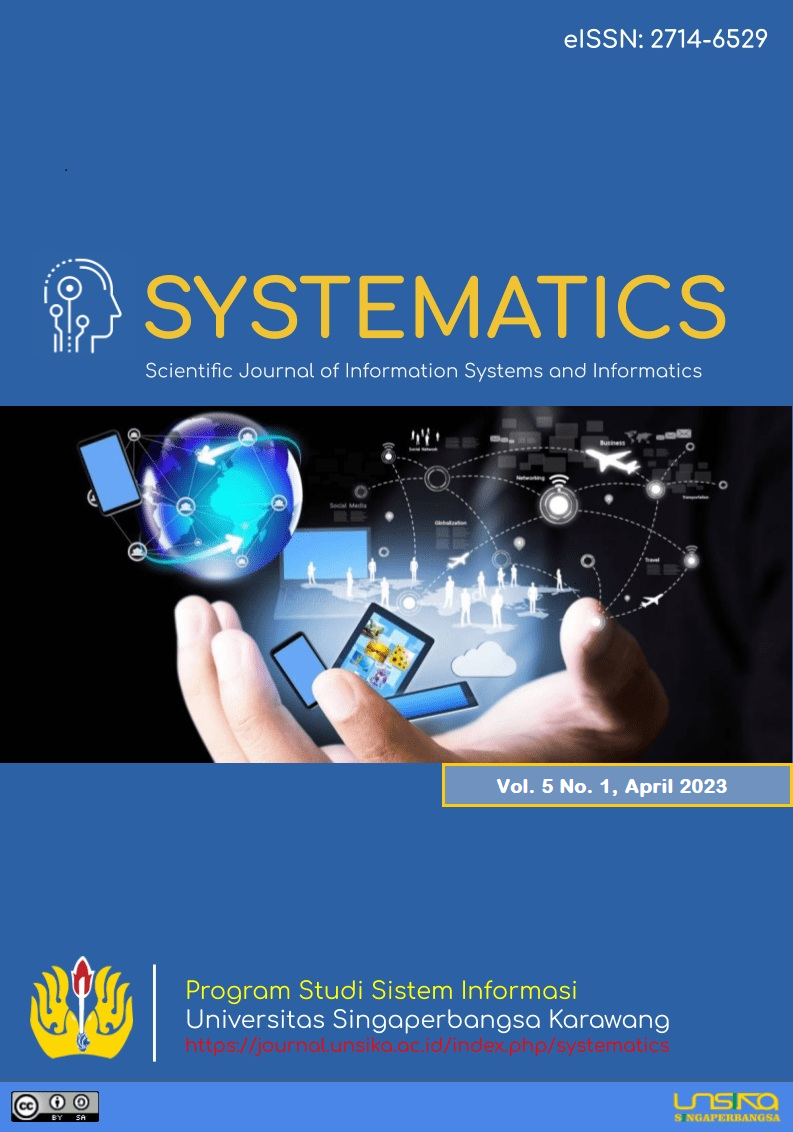Decision Support Systems For Teacher Performance Evaluation at SDI Darul Mu’minin With Analytical Hierarchy Process And Simple Additive Weighting Methods
Sistem Pendukung Keputusan Evaluasi Kinerja Guru di SDI Darul Mu’minin Dengan Proses Hierarki Analitik Dan Metode Additive Weighting Sederhana
DOI:
https://doi.org/10.35706/sys.v5i1.8668Abstract
Teacher performance evaluation is one of the efforts to raise the standard of education at SDI Darul Mu'minin. SDI Darul Mu'minin, which is located in Larangan Indah Village, Larangan sub-district, Tangerang City, has a teacher performance assessment that is conducted once a year. In addition to raise the standard of education, the purpose of the assessment is to select exemplary teachers. However, the process of assessing teacher performance is not on target because the assessment process only uses attendance criteria and does not yet have the right method. Therefore the principal added several additional criteria, namely: responsibility, lesson plans, loyalty and reporting of student grades. To implement a multi-criteria assessment, a decision support system is needed. This study uses the AHP and SAW methods and produces weights namely Responsibility 33%, Loyalty 28%, Attendance 18%, Lesson Plans 13% and Reporting of Student Values 8% and produces the best alternative, namely the best performing teacher with a value of 0.9930. The goal of this research is to decide the best alternative, namely the best performing teacher who will receive a prize or reward in the form of money at the end of each academic year.
Downloads
References
T. Hidayat, F. Widiyanto, and Y. K. Hasim, “Rancang Bangun Decision Support System Pemilihan Guru Terbaik Menggunakan Metode Simple Additive Weighting (Saw) (Studi Kasus : Sma Bhakti Pertiwi Kota Tangerang),” JUTIS J. Informatics Eng., vol. 5, no. 1, pp. 52–56, 2017.
R. D. Heriyantoro, M. I. Dzulhaq, and L. S. M. Silitonga, “Sistem Pendukung Keputusan Penentuan Guru Berprestasi dengan Metode AHP dan SAW pada SMA Markus Tangerang,” Acad. J. Comput. Sci. Res., vol. 2, no. 2, pp. 2–9, 2020, doi: 10.38101/ajcsr.v2i2.284.
A. Afrizal, D. Dedi, and B. Anggundari, “Sistem Pendukung Keputusan Penilaian Kinerja Mekanik Menggunakan Metode AHP dan TOPSIS,” J. Tren Bisnis Glob., vol. 1, pp. 79–89, 2021, doi: 10.30865/mib.v5i4.3235.
J. S. Wijayanto Joko, “Pemodelan Sistem Penunjang Keputusan Pemilihan Guru,” J. Idealis, vol. 4, no. 1, pp. 98–107, 2021.
R. Hamdani, S. Fadillah Rezeky, and D. Suherdi, “PENERAPAN METODE TOPSIS DALAM MENENTUKAN GURU TERBAIK PADA SISTEM PEMBELAJARAN DARING PADA YAYASAN PENDIDIKAN PANCA ABDI BANGSA,” J. Tek., vol. 1, pp. 72–82, 2021.
N. H. Daulay, S. D. Nasution, and F. Fadlina, “Sistem Pendukung Keputusan Seleksi Fasilitator Sumber Daya Manusia Menggunakan Metode Electre (Studi Kasus: Dinas Kesehatan Sibuhuan),” JURIKOM (Jurnal Ris. Komputer), vol. 7, no. 3, p. 390, 2020, doi: 10.30865/jurikom.v7i3.2172.
N. S. Sopiah and A. Diana, “Implementasi Decision Support System Penilaian Kinerja Guru Terbaik Di Sdn Kebayoran Lama Selatan 17 Pagi Dengan Metode Analitycal Hierarchy Process ( Ahp ) & Simple Additive Weighting ( Saw ),” vol. 9, no. April, pp. 223–230, 2017.
Fitri Duwiyanti, “Sistem Pendukung Keputusan Pemilihan Guru Terbaik di SMK Pustek Serpong Dengan Menggunakan Metode TOPSIS,” Int. J. Educ. Sci. Technol. Eng., vol. 2, no. 1, pp. 45–67, 2019, doi: 10.36079/lamintang.ijeste-0201.18.
E. Affandi and T. Syahputra, “Pemodelan UML Manajeman Sistem Inventory,” J. Teknol. Sist. Inf. dan Sist. Komput. TGD, vol. 1, no. 2, pp. 14–25, 2018.
H. J. Pramana, T. Mufizar, D. S. Anwar, and I. Septianingrum, “Sistem Pendukung Keputusan Penilaian Kinerja Guru Dengan Metode AHP dan PROMETHEE,” It (Informatic Tech. J., vol. 10, no. 1, p. 87, 2022, doi: 10.22303/it.10.1.2022.87-99.
A. Amijaya, F. Ferdinandus, and M. Bayu, “Sistem Pendukung Keputusan Pemilihan Handphone Dengan Metode Simple Additive Weghting Berbasis WEB,” CAHAYAtech, vol. 8, pp. 2580–2399, 2019.
Downloads
Published
How to Cite
Issue
Section
License
Copyright (c) 2023 SYSTEMATICS

This work is licensed under a Creative Commons Attribution-ShareAlike 4.0 International License.
Authors who publish with this journal agree to the following terms:
- Authors retain copyright and grant the journal right of first publication with the work simultaneously licensed under a Creative Commons Attribution-ShareAlike 4.0 International License. that allows others to share the work with an acknowledgement of the work's authorship and initial publication in this journal.
- Authors are able to enter into separate, additional contractual arrangements for the non-exclusive distribution of the journal's published version of the work (e.g., post it to an institutional repository or publish it in a book), with an acknowledgement of its initial publication in this journal.
- Authors are permitted and encouraged to post their work online (e.g., in institutional repositories or on their website) prior to and during the submission process, as it can lead to productive exchanges, as well as earlier and greater citation of published work (See The Effect of Open Access).







